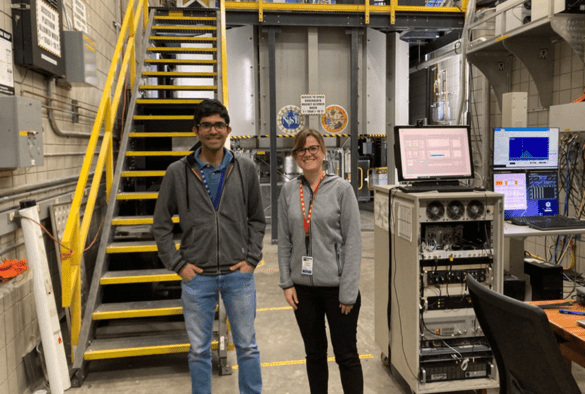Chemistry PhD student visits the most powerful nuclear magnetic resonance (NMR) magnet in the world

Lucia Corti, a PhD student in the Department of Chemistry, travelled to Florida in summer 2023 to operate the most powerful nuclear magnetic resonance (NMR) spectrometer in the world.
The world-wide unique system is located at the National High Magnetic Field Laboratory (NHMFL) in Tallahassee, Florida, and operates at 35 T (equivalent to a 1H frequency of 1.5 GHz) which is about one million time stronger than the Earth magnetic field. This equipment uses a novel series-connect hybrid magnet technology combining a superconducting magnet outsert and a resistive insert that minimises the high frequency fluctuations of the magnetic field providing the significant time and field stabilities needed for high resolution NMR experiments.
NMR is arguably one of most powerful structure determination techniques and two key limiting factors of sensitivity and resolution must be overcome to exploit this spectroscopy to the best of its capability – this is best achieved at the highest magnetic field available. In particular, a certain type of NMR active nuclei that also possess a quadrupolar moment benefit even further from high magnetic fields.
Access to this system was thus used to collect NMR data on several of these quadrupolar nuclei present in solid fuel cell materials. The data yield impressive spectral resolution enhancement that is crucial to unambiguously capture some of the key structural features of the materials interrogated and could be linked to their chemical function.
Dr. Amrit Venkatesh, Research Faculty I at the NHMFL said: “Maglab’s leadership in the development of next-generation high-field magnet technology such as the 35 T system opens up new avenues in magnetic resonance and its application to chemistry”.
Professor Frédéric Blanc from the University’s Department of Chemistry, Stephenson Institute for Renewable Energy and the High-Field NMR Facility noted: “The 35 T magnet is a very exciting NMR equipment and is made available to any researchers around the world via the NHMFL user programme and is transformative to address key characterisation challenges.”
The work “Local Structure in Disordered Melilite Revealed by Ultrahigh Field 71Ga and 139La Solid-State Nuclear Magnetic Resonance Spectroscopy” is now published in the journal ChemPhysChem. Part of this work was funded by the Leverhulme Research Centre for Functional Materials Design.